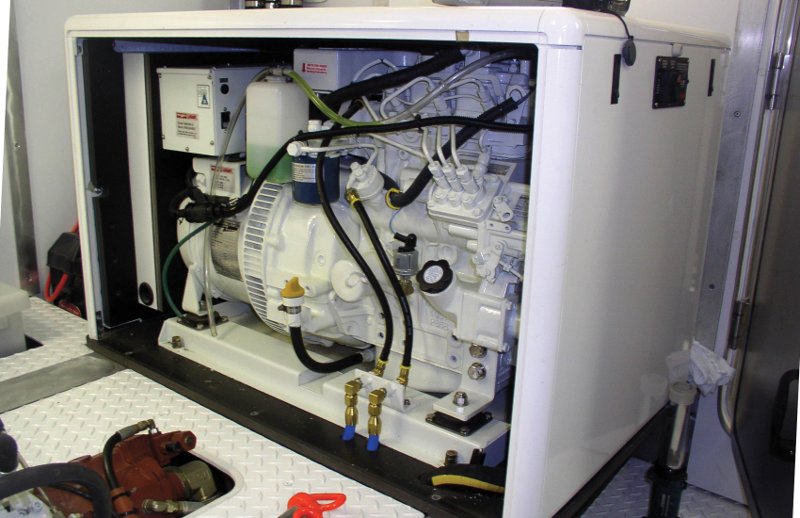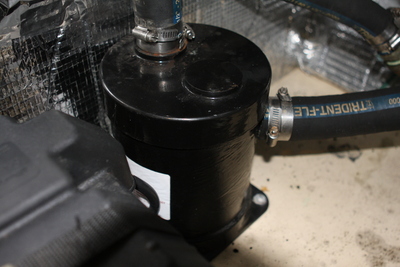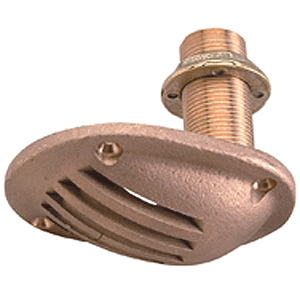

 Share This Page
Share This Page| Home | | Sailing | | Alaska 2011 | |  |  |  Share This Page Share This Page |

Copyright © 2011, P. Lutus. All rights reserved. Message Page
| Prior years: |
Alaska 2002 |
Alaska 2003 |
Alaska 2004 |
Alaska 2005 |
Alaska 2006 Alaska 2007 | Alaska 2008 | Alaska 2009 | Alaska 2010 |
(double-click any word to see its definition)

Figure 1: Typical Marine Diesel Generator
Now I switch gears — from describing natural adventures to describing a very unnatural one. Distinctly, spectacularly unnatural. Unnatural even by the tastes of people who mostly think about diesel engines.
Let me start at the beginning. Sometime in 2001, a worker at the Northern Lights generator factory pushed a relay into a socket in the usual way, but this time, something very unusual happened — instead of engaging the socket's connections, one of the relay's pins pushed its mating connector right out of the bottom of the socket. This particular relay controlled power to the engine's glow plugs, but because of this mishap, the generator couldn't power its glow plugs.
These sorts of things happen in manufacturing, which is why companies have quality control (QC) departments, whose job it is to catch things like this. But this defect wasn't caught — the generator, still unable to power its glow plugs, was delivered to the Nordic Tug factory and installed on my boat.
It happens that I had never owned a large diesel generator before, and I had no way to know that it should have been much easier to start than it was. I regularly had to crank this generator for 20 or more seconds before it would start, and that only worked on a warm day. Coincidentally (or perversely), this generator has a water-lift muffler (Figures 2 and 3 below), and if you crank the starter on such an engine for 20 or more seconds, the water pump impeller will go dry and disintegrate. If the water pump impeller begins to disintegrate, this limits cooling water flow and causes the generator to overheat. If the generator regularly overheats, this will destroy the thermostat, which means even if you replace all the destroyed parts, the engine still won't run at the right temperature.
No, boys and girls, I'm not making this up — it was like dominoes falling in slow motion. To reiterate:During factory assembly, instead of making contact, a relay pin pushed away its mating connection, preventing the relay from working.
The relay failure prevented the glow plugs from working.
A simple factory defect (the failed relay contact) and its consequence (no glow plugs) should have been caught by quality control and fixed at the factory, but was not.
Because the defect wasn't caught, the generator was delivered to my boat with inoperative glow plugs.
Because the glow plugs weren't working, the engine was very difficult to start.
Because the engine took so much cranking to start, the cooling water pump impeller would disintegrate in a short time.
Because the water pump impeller would quickly disintegrate, the engine was always on the verge of overheating.
Because the engine was always overheating and shutting down, the thermostat became damaged, which assured more overheating episodes, even when everything else was working properly.
The result is that I have fought with this generator almost constantly for the ten years I've owned my Nordic Tug. I've had to keep a supply of pump impellers on hand, and would go through several of them during a cruising season. But over time, because the thermostat was exposed to elevated temperatures so often, it gradually lost its ability to regulate the engine's temperature.
As the years passed I began to compare notes with boat owners who owned similar generators, and it eventually dawned on me that my generator wasn't normal. Then it occurred to me that the glow plugs weren't working (a diesel engine's glow plugs only serve to assist in starting, they have no other purpose). But being a solo boat operator, I had no way to measure the glow plug voltage at the generator in the engine compartment, while simultaneously engaging a momentary-contact switch that activated them, located in the pilot house.
But a few years ago I wired up a special test tool meant to address this classic solo sailor problem (needing to be in two places at once) — a 12 volt buzzer attached to two test leads — that could be attached to something at one end of the boat, so I could hear it while throwing a switch forty feet away at the other end. And I finally applied this new gadget to the generator problem — I attached the buzzer to the glow plug circuit in the engine compartment, then tried activating the glow plugs in the pilot house. No voltage! This was the first step in actually analyzing and solving the generator's problems.
Now that I knew what the problem was, I took the generator apart and examined each part using a magnifying glass. I finally noticed something funny at the bottom of one of the relay sockets — a contact that should have been firmly rooted in the socket had instead been pushed out, and wasn't making contact at all. I pushed it back in place and heard a small click sound as it engaged with the relay. After reassembling the generator, I was able to start it in three seconds. I will confess to my readers that, when this happened, when the generator started immediately for the first time ever, I uttered an oath that set off car alarms a block away.
But this was only the beginning — I still had to clean out all the bits and pieces of shredded impeller that, over the years, had distributed themselves all through the engine's cooling system. And I hadn't yet realized that the thermostat, responsible for maintaining a temperature of 170° Fahrenheit, had long since been cooked by overheating episodes and was no longer functioning.
This season, having solved the glow plug problem and having replaced the impeller once again, I noticed the engine still wasn't maintaining a reasonable temperature. I decided the only remaining possibility was the thermostat itself, and because I had a spare on hand, I installed it. Then, for the first time since I bought this boat in 2001, the generator started quickly, and within minutes, the temperature gauge moved up to 170°F and stabilized there. This had never happened before, not at the boat dealership, not after I had a diesel mechanic examine the engine, never.
And to think — all this could have been avoided by a diligent QC person at the Northern Lights factory, running a simple test before packing and shipping the generator.
I hope no one gets the wrong idea — I happen to think Northern Lights builds a decent generator, well-designed, and in principle able to provide years of reliable service. And now that I have solved its problems, I expect this generator will provide those years of reliable service. No one should take this article as unfair criticism of Northern Lights — I think their products are of superior quality. But their QC department may need help.
Here are some more hints about marine diesel generators that boat owners may find useful:During normal generator operation, don't switch on the generator breaker until the generator is running at normal speed, and always switch off the breaker before shutting down the generator. The reason for this is that many kinds of electrical equipment can only be operated at a line frequency of 60 Hz (U.S.) (that's a generator speed of 3600 RPM) and if you try to operate them at any other frequency, some may fail. This is particularly true for transformer equipment — for reasons I won't try to explain, transformer equipment is especially sensitive to frequencies lower than 60 Hz, and some devices may fail if exposed to lower frequencies even briefly. Over the years I have had to throw away any number of transformer-related gadgets because my generator would overheat and automatically shut itself down before I could disengage the breaker.
If you don't have a screen over the generator raw water intake at the bottom of your boat, have one installed as soon as possible (see Figure 4 below). One of the reasons for cooling failures on my boat was the fact that there was originally no screen over the water intake port, which allowed large pieces of floating vegetation to be sucked up with the cooling water, which clogged the intake filter, which destroyed the pump impeller and caused the generator to overheat. Ironically, nearly all diesel-powered boats have a screen over the propulsion engine's water intake to prevent this exact problem, but not one over the generator's water intake.
Many boat diesel generators have what are called "water lift mufflers," whose purpose is to keep the generator quiet. These mufflers have two output ports, one for liquid and one for gases. Inside the boat, next to the generator, there is typically a big box that serves to separate the liquid and the exhaust gases (see Figure 3 below). Over time this box gets clogged with carbon. Unless the carbon is cleaned out, it begins to produce high back pressure and, apart from contributing to overheating, may cause your raw water pump's seals to fail. Periodically remove this box and clean it, say, every four years on a frequently used boat.
An easily detected sign that the water lift muffler needs cleaning is the appearance of large gas bubbles in the output liquid flow from the side of your boat. Many small bubbles is normal, large bubbles is not.
One more thing about the rectangular water-lift muffler component shown in Figure 3: once you have unmounted it, be sure to put it into an oversize garbage bag before trying to move it out of the engine room. I suggest this because, after a few years of use, it will be filled with the same kind of nasty carbon one finds in a dry copier — the kind that, if spilled, makes seemingly indelible black marks everywhere and is a great pain to clean up.
Summary:
This story emphasizes a point I've made before, in my book Confessions of a Long-Distance Sailor — if you want something done right, you must do it yourself. It doesn't matter who you are, how much money you have, how many experts you consult — you either put up with things not working as they should, or you get your hands dirty, deep in the bowels of your boat, and learn everything about it — every screw, every wire. There is no middle way.
As told in my sailing book, an earlier learning experience was somewhat more dramatic. I had gotten all the way to Egypt, halfway around the world, on a small sailboat with a misbehaving diesel engine, only to have it fail at the worst possible time and place (you must motor along the Suez Canal, you aren't allowed to sail). After naively hiring a series of diesel mechanics, none of whom could figure out what was wrong, I finally disassembled the engine and sorted out its problems on my own.
Unfortunately, this philosophy — understand it yourself, do it yourself — is completely at odds with the nature of American society in the early 21st century. Most Americans don't own tools and don't build or fix anything, and this represents a fundamental change in outlook since the end of World War II. And with rare exception, even boat owners don't do their own work or understand their boats. We've become a nation of passive consumers of goods and services produced by others.
Much is being made right now about the disappearance of the middle class, certainly a deplorable trend. But the change I'm describing — the disappearance of skilled, self-sufficient people — is related and to me seems more alarming. I see it as a sign of decline, of abandonment of essential principles.
Pictures:

Figure 2: Cylindrical part of water-lift muffler
Hose at right: input of mixed exhaust gas and cooling water from engine |
 Figure 3: Rectangular part of water-lift muffler Upper hose: gas exhaust overboard Lower hose: Liquid exhaust overboard (Should be periodically removed and cleaned) |
 Figure 4: Water intake screen, highly recommended for generator cooling water intake port |
| Home | | Sailing | | Alaska 2011 | |  |  |  Share This Page Share This Page |